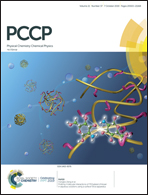Quantifying individual (anti)bonding molecular orbitals’ contributions to chemical bonding†
Abstract
The shapes of molecular orbitals (MOs) in polyatomic molecules are often difficult for meaningful chemical interpretations. We report protocols to quantify contributions made by individual orbitals (molecular canonical and natural) of classical bonding, non-bonding or anti-bonding nature to (i) electron density into the inter-nuclear region and (ii) diatomic electron delocalization, DI(A,B). In other words, these protocols universally explain orbital's inputs to two fundamental and energy-lowering mechanisms of chemical bonding (interactions) and ease the chemical interpretation of their character in polyatomic molecules. They reveal that the MO and real-space density descriptions of the interactions are equivalent and, importantly, equally apply to all atom-pairs regardless if they are involved in a highly attractive or repulsive interaction. Hence, they not only remove ambiguity in chemical bonding interpretations (based on either MO or electron density approaches) but also demonstrate complementarity between the two such seemingly different techniques. Finally, our approach challenges some classical assumptions about MOs, such as the role of core electrons, the degree of bonding in antibonding MOs and the relative importance of frontier orbitals. Just as an example, we show that orthodox antibonding orbitals can make a significant contribution of a bonding nature to a classical covalent bond or major contribution to DI(A,B) of an intramolecular and highly repulsive H⋯H interaction.



 Please wait while we load your content...
Please wait while we load your content...